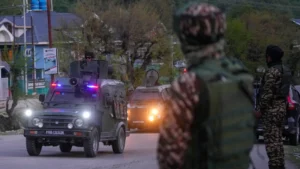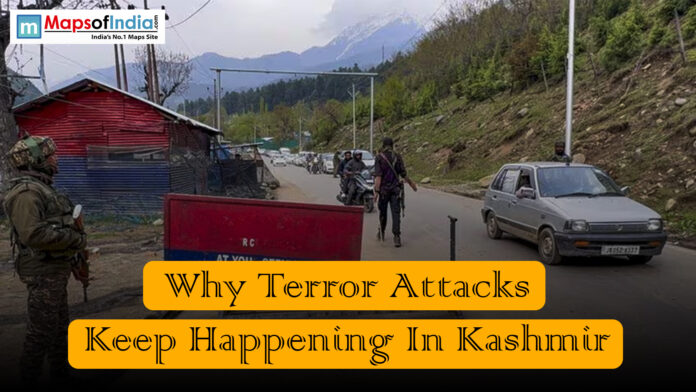Why Terror Attacks Keep Happening in Kashmir
Kashmir has been a region torn apart by conflict for many years. Days often pass without peace, as violence and terror attacks hit almost every community there. People who live in Kashmir constantly face danger, fear for their safety, and the pain of losing loved ones. The ongoing violence tears families apart and destroys homes, leaving a trail of grief and disruption. Understanding why these attacks happen so often is key to finding a way to bring peace to the region. It’s not just about stopping the violence but also about understanding its roots. The conflict in Kashmir is complex and has deep roots that stretch back many decades. It is shaped by a mix of history, politics, and social issues that are all connected. Both countries claim Kashmir as their own, which has led to wars and constant tension. Over time, many local groups have also fought for independence or greater rights, adding to the chaos. The political situation is often unstable, with governments changing and peace talks breaking down repeatedly. Social issues like poverty, unemployment, and lack of education make many people vulnerable and more likely to join groups involved in violence. To truly solve this problem, we need to look at all these factors carefully. We must understand how history has shaped current tensions. We need to consider how political decisions have fueled unrest. We should also recognize the social challenges that leave many feeling hopeless. Only by examining all these parts together can we find a path toward peace. Without addressing the deep causes of the conflict, violence will likely continue. Building peace requires effort from all sides, understanding each other’s viewpoints, and working toward solutions that last.
Historical Context and Political Background of Kashmir
Roots of the Kashmir Conflict
The story of Kashmir’s conflict begins back in 1947 during the Partition of India. When British India was split into two new countries, India and Pakistan, regions with different religious majorities faced tough choices. Kashmir was one such region. It was mostly Muslim, but its ruler was a Hindu prince. This created a big problem because the local people had different beliefs from their ruler. The Hindu prince was unsure whether to join India or Pakistan. But this decision did not settle the dispute.
Soon after, the ruler chose to accede to India. He signed an agreement that made Kashmir part of India. This decision angered many in the Muslim-majority area, who wanted to join Pakistan or become independent. The first confrontation, the Indo-Pakistani War of 1947–1948, was caused by the move. The war ended with a United Nations ceasefire, creating a line called the Line of Control, which still divides Kashmir today. However, the dispute was not settled. Both India and Pakistan claimed the entire region, and tensions continued to grow.
Over the years, the conflict has worsened. Both countries fought additional wars over Kashmir in 1965 and 1999. These wars caused enormous suffering and loss of life. The region has seen ongoing violence and military skirmishes. Many Kashmiris want independence or want to join Pakistan instead of being part of India. Some groups have taken up arms and launched insurgencies. These uprisings resulted from decades of frustration, economic hardship, and demand for self-rule.
Today, Kashmir remains a flashpoint in South Asia. The region faces constant military presence, restrictions on movement, and human rights concerns. The dispute affects millions of lives and fuels tensions between India and Pakistan, two nuclear-armed nations. Despite many peace talks, a lasting solution remains elusive. The Kashmir conflict is one of the longest unresolved issues stemming from the Partition, with roots that go back more than 75 years. It continues to shape the politics and security of the region.
Political Dynamics and Governance

Kashmir’s local governments are caught between regional demands and Delhi’s control. Policies from the Indian government often influence unrest. Military operations are common, and heavy security stays in place. This presence creates tension. Political parties in the region have different views, some supporting peace while others push for more independence. Their actions can sometimes escalate violence instead of reducing it.
Influence of International Factors
The conflict isn’t just local. Tensions between India and Pakistan have existed for a long time. Cross-border fighting and infiltrations happen often. Pakistan supports some militants in Kashmir, fueling violence. China also has a stake in the region, especially in the northern areas. Global politics add fuel to the fire, making peace even harder to achieve.
Cultural and Religious Influences
Religion plays a crucial role in shaping identities in Kashmir. It influences how many people see themselves and their place in society. Religious beliefs and practices are a big part of everyday life for many Kashmiris. The importance of religion often deepens emotional bonds and provides a sense of belonging. But it can also be used by extremist groups to influence young people. These groups often target youth to spread their ideas of radical Islam or nationalism. They use religious sentiments to attract young minds that are searching for meaning or guidance.
Extremist groups in Kashmir use propaganda to push their views. They produce leaflets, videos, and online messages that justify violence. They tell young people that fighting is part of their religious duty or that it is necessary to free their land. This kind of propaganda makes violent acts seem justified or even noble. It twists religious teachings to serve their agenda, convincing some that violence is the only way to achieve their goals.
Many young Kashmiris feel disconnected from their own culture and history. They see little support from their community or government. Some feel forgotten or ignored, which leaves them feeling isolated. They may also see their culture as under threat from outside forces or modernization. Feeling alienated from their roots pushes some toward extremism. They believe that extreme actions are the only way to defend their identity and preserve their way of life.
The cycle of radicalization is helped by the ongoing conflict that divides and destabilizes the region. Schools, homes, and communities are affected, making life harder for young people. With limited opportunities and rising frustrations, some turn to extremist groups for a sense of purpose or belonging. Religion in Kashmir is more than just faith; it is entwined with identity, politics, and social issues. This complex mix makes it easier for extremist groups to recruit and radicalize youth by tapping into deep-seated feelings and beliefs.
Impact of Human Rights Issues and Civil Discontent
Allegations of abuse by security forces greatly increase distrust among the people. When reports of violence and mistreatment surface, they deepen fears and make communities question the motives of those meant to protect them. People start to see security forces as enemies rather than allies. This mistrust makes it harder for authorities to keep peace and effectively control unrest. Over time, the community’s frustration can grow into anger and resentment. People frequently express their annoyance through civil protests. People frequently congregate in big groups to voice their complaints or demand change. However, these protests are frequently met with harsh responses from security forces. When police or soldiers use force — tear gas, beatings, or even arrests — it reinforces the idea that the government does not listen or care. This cycle of protest and suppression only makes residents more upset.
Many people start to see violence as the only way to be heard. When peaceful efforts seem to have no impact or are ignored, anger turns into action. Some individuals or groups may resort to violence to get attention or to fight back. For example, in some places, protests have turned into riots after authorities responded with excessive force. This cycle continues to feed itself: individuals lash out because they feel ignored, and authorities respond with more force, escalating the tension.
This ongoing pattern creates a cycle of mistrust and violence that is tough to break. Communities feel increasingly alienated and fearful. The more they see their voices silenced or their protests suppressed with violence, the more they believe there is no real way to change their situation peacefully. As a result, violence becomes normalized. It starts to seem like the only way to make officials listen.
In many cases, this cycle causes long-term damage. It erodes the social fabric and makes reconciliation harder later. When people are hurt or find their appeals ignored, they lose faith in their government and security forces. This deep mistrust can persist for years, causing instability and ongoing unrest in the area. Without trust, efforts to rebuild peace and harmony become even more difficult to achieve.
Cross-Border and External Influences
Pakistan’s Support for Militants
Pakistan’s support for militants has a long history. They fund and train insurgent groups operating in Kashmir. Tensions escalate whenever Pakistan violates ceasefire agreements or allows infiltration. This support keeps violence alive and makes peace hard to find.
Role of Non-State Actors and Terrorist Groups
Groups like Lashkar-e-Taiba and Hizbul Mujahideen operate in the region. They carry out attacks, recruit youth, and spread fear. Many have links to larger terrorist networks around the world. Their tactics include guerrilla warfare and bombings, making Kashmir’s streets unsafe.
Influence of External Political Agendas
Outside powers like regional nations and global players sometimes pursue their own goals through Kashmir. Power struggles and diplomatic policies worsen the situation. External political interests often prioritize regional dominance over peace efforts, pushing the conflict further.
Political and Diplomatic Initiatives
Peace talks between India and Pakistan come and go. They rarely produce lasting results. Confidence-building measures help temporarily but don’t fix deep issues. Dialogue must be genuine and include Kashmir’s voice.
Conclusion
The violence in Kashmir has many roots. It’s driven by history, politics, social issues, and external influences. No single solution will stop terror attacks overnight. Instead, combined efforts are needed—politically, socially, and security-wise. If leaders and communities work together, lasting peace in Kashmir can become a reality.
Sound policies, open dialogue, and community involvement will pave the way for a brighter, more peaceful future where terror attacks are just a thing of the past.




